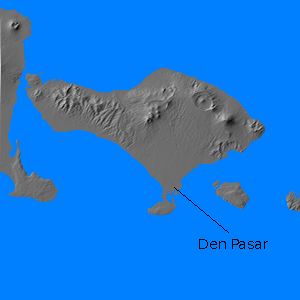![]() The Pacific War Online Encyclopedia
The Pacific War Online Encyclopedia
|
| Previous: Balao Class, U.S. Submarines | Table of Contents | Next: Balikpapan |

Bali is a modest-sized island, 90 miles (144 km) long and 55 miles (89 km) wide with an area of 2175 square miles (5633 km2). It located just east of Java in the Netherlands East Indies. It has a chain of six volcanoes running from east to west, of which the tallest reaches 10,308' (3142 meters). These are sufficiently active that the beaches are all black sand except for the southern extremity of the island. The island is covered with jungle. The monsoon comes from out of the west from December to March.
The native population is mostly Hindu, and the island is famous for its atmosphere of tranquility. This was shattered during the Pacific War, on 19 February 1942, when Japanese forces seized the airfield at Den Pasar to support the eastern pincer of their drive on Java.
Following their conquest of Makassar
on 8 February 1942, the Japanese
found that the airfield was
frequently clouded in and unsuitable for
supporting the eastern prong of the upcoming Java operation. The Japanese therefore
improvised a plan to take Den Pasar airfield on Bali to provide the
needed air support. The Allies became
aware of Japanese intentions on 9 February, presumably from radio intelligence, but were
unable to gather a strike force until 19 February. By then the Japanese
had already landed the bulk of their forces on Bali, undisturbed except
by a handful of B-17s and submarine Seawolf.
The B-17s managed to badly damage Sagami
Maru, which was escorted from the area by destroyers Arashio
and Michishio that afternoon.
Rather than attempt to assemble his forces in the face of the enemy, Doorman chose to have them attack in three separate waves. The first wave, consisting of two light cruisers and three destroyers under Doorman's personal command sailing from Tjilatjap, struck just before midnight on 19 February. They arrived just as transport Sasago Maru got under way, accompanied by destroyers Asashio and Oshio. The Japanese destroyers spotted the Allied ships first and immediately moved out to engage. The two forces exchanged gunfire and torpedo salvos before the Allied force withdrew to the north. Sasago Maru was damaged by gunfire and a torpedo hit and Piet Hein was sunk by Japanese torpedoes. The Japanese destroyers then returned to the damaged transport. What should have been a pushover for the Allied force ended up costing a destroyer without any compensating loss to the enemy.
Shortly after midnight the second Allied wave, consisting of a light cruiser and four destroyers, entered Bandung Strait. Their torpedo attack was ineffective, and the fully alerted Japanese destroyers answered with rapid and accurate gunfire, seriously damaging a destroyer and the cruiser Tromp. Oshio was slightly damaged by Allied gunfire. The second Allied wave then began to withdraw to the north, only to encounter destroyers Arashio and Michishio, which had left their transport and rushed back to Bandung Strait. Michishio was badly damaged before the forces disengaged.
The final Allied wave was two groups of four Dutch motor torpedo boats each, which passed clear through the strait without identifying a clear target or being themselves spotted.
The outcome was one Japanese destroyer badly damaged, two destroyers lightly damaged, and two transports damaged, while the Allies had a destroyer sunk, another destroyer damaged, and a light cruiser badly damaged.
| First
group |
Under way for Makassar |
|
| DD Arashio DD Michishio AP Sagami Maru (7189 tons, 18 knots) |
||
| Second
group |
||
| |
DD Asashio DD Oshio AP Sasako Maru (7158 tons, 18 knots) |
|
| First
wave |
Arriving from Tjilatjap |
|
| |
CL De
Ruyter CL Java DD Piet Hein DD Pope DD John D. Ford |
|
| Second
wave |
Arriving from Surabaya |
|
| CL Tromp DD Stewart DD Parrott DD John D. Edwards DD Pillsbury |
||
| Third
wave |
||
| TM-4 TM-5 |
||
| TM-6 | Hit a buoy leaving harbor and did not participate |
|
| TM-7 TM-9 TM-10 TM-11 TM-12 |
||
References
The Pacific War Online Encyclopedia © 2007, 2010 by Kent G. Budge. Index